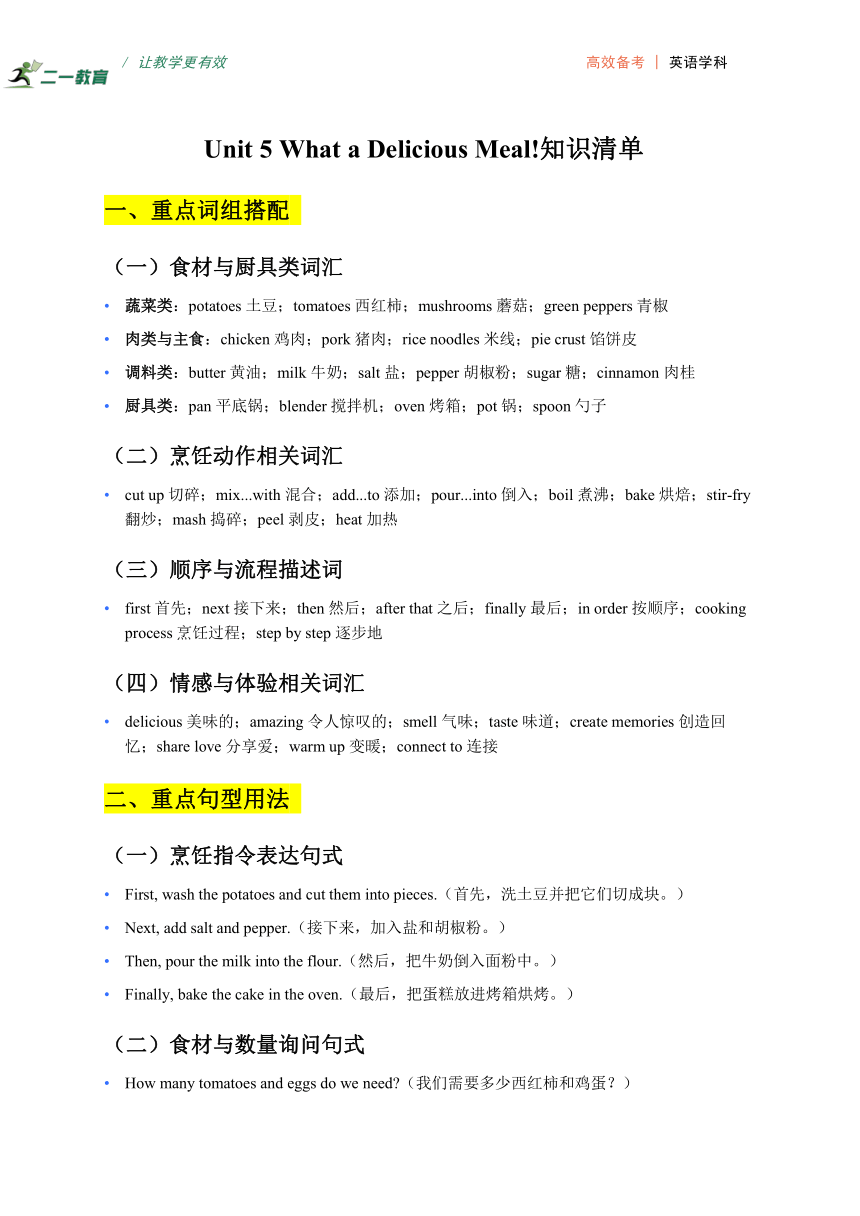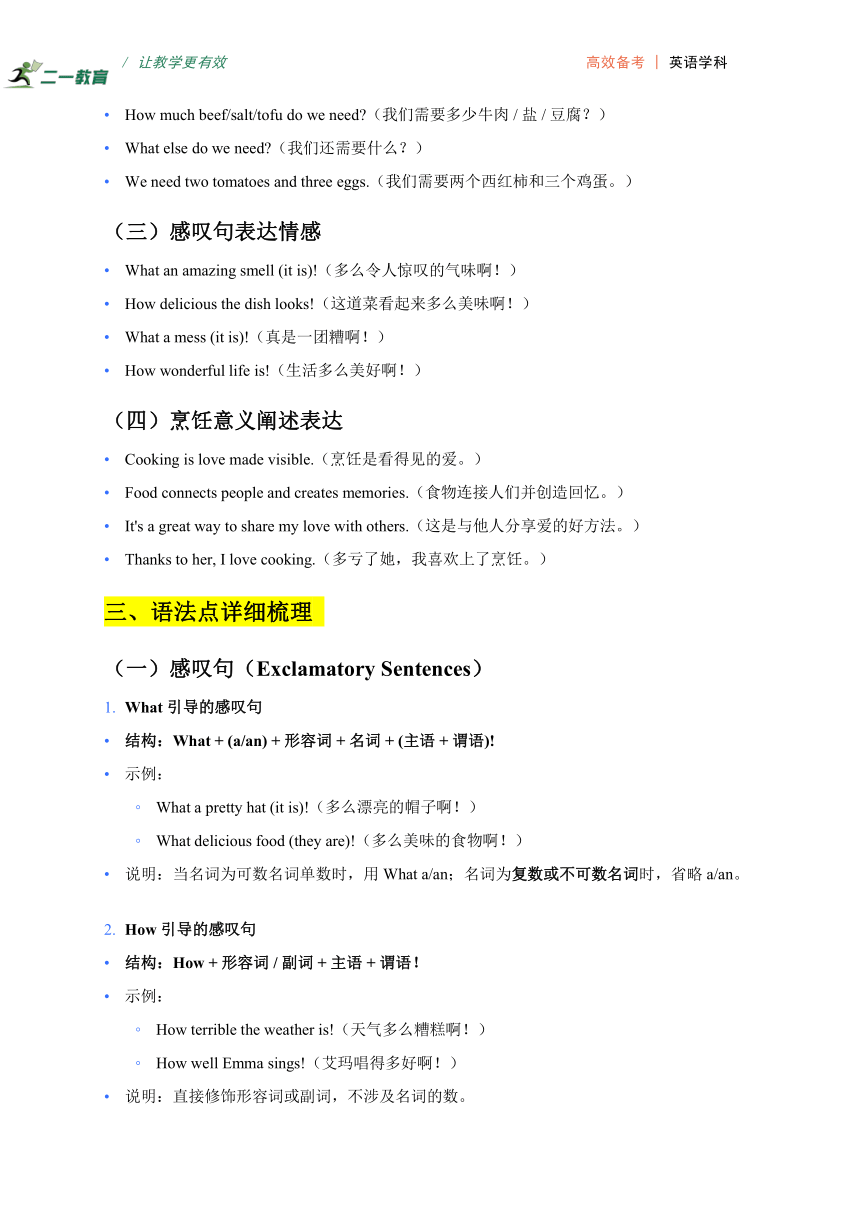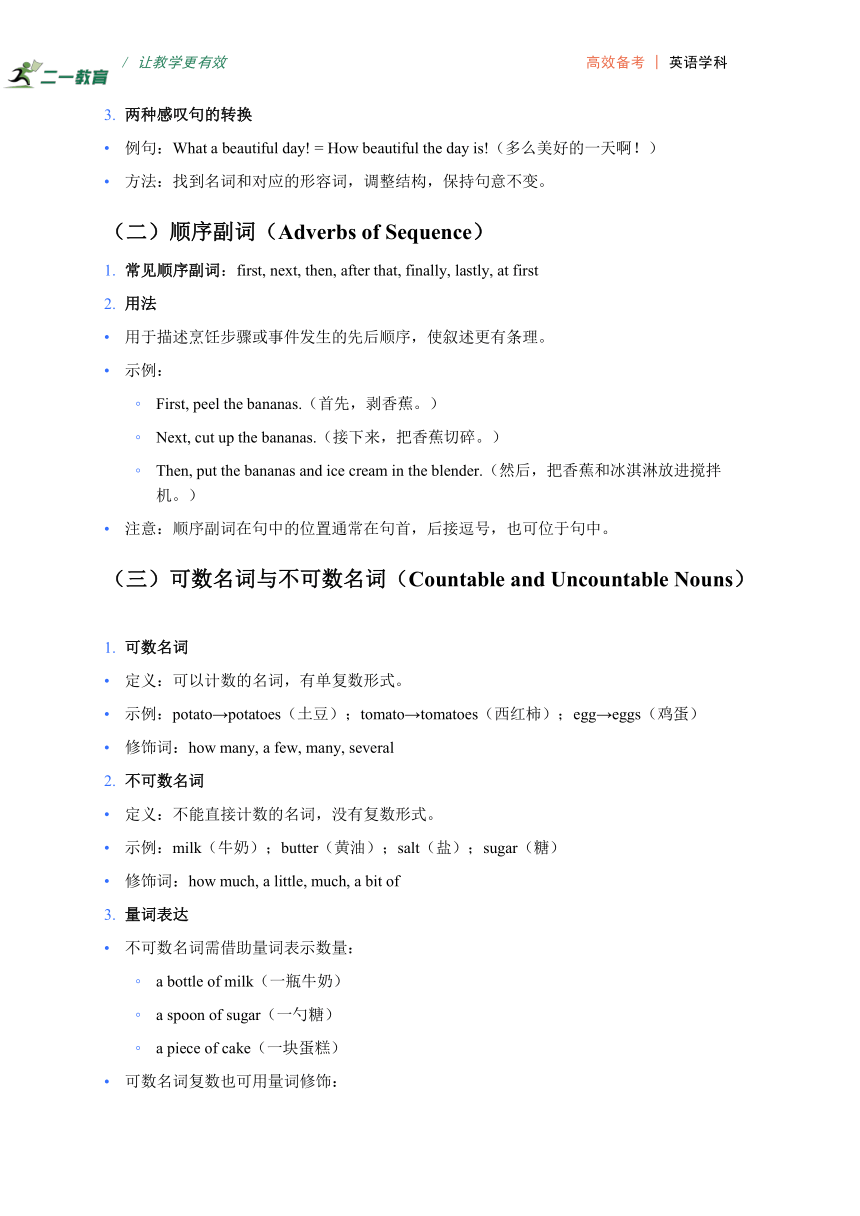人教版八年级上册英语新教材Unit 5 What a Delicious Meal! 知识清单 (含写作指导)
文档属性
| 名称 | 人教版八年级上册英语新教材Unit 5 What a Delicious Meal! 知识清单 (含写作指导) |  | |
| 格式 | docx | ||
| 文件大小 | 35.8KB | ||
| 资源类型 | 试卷 | ||
| 版本资源 | 人教版 | ||
| 科目 | 英语 | ||
| 更新时间 | 2025-05-27 08:06:19 | ||
图片预览



文档简介
/ 让教学更有效 高效备考 | 英语学科
Unit 5 What a Delicious Meal!知识清单
一、重点词组搭配
(一)食材与厨具类词汇
蔬菜类:potatoes 土豆;tomatoes 西红柿;mushrooms 蘑菇;green peppers 青椒
肉类与主食:chicken 鸡肉;pork 猪肉;rice noodles 米线;pie crust 馅饼皮
调料类:butter 黄油;milk 牛奶;salt 盐;pepper 胡椒粉;sugar 糖;cinnamon 肉桂
厨具类:pan 平底锅;blender 搅拌机;oven 烤箱;pot 锅;spoon 勺子
(二)烹饪动作相关词汇
cut up 切碎;mix...with 混合;add...to 添加;pour...into 倒入;boil 煮沸;bake 烘焙;stir-fry 翻炒;mash 捣碎;peel 剥皮;heat 加热
(三)顺序与流程描述词
first 首先;next 接下来;then 然后;after that 之后;finally 最后;in order 按顺序;cooking process 烹饪过程;step by step 逐步地
(四)情感与体验相关词汇
delicious 美味的;amazing 令人惊叹的;smell 气味;taste 味道;create memories 创造回忆;share love 分享爱;warm up 变暖;connect to 连接
二、重点句型用法
(一)烹饪指令表达句式
First, wash the potatoes and cut them into pieces.(首先,洗土豆并把它们切成块。)
Next, add salt and pepper.(接下来,加入盐和胡椒粉。)
Then, pour the milk into the flour.(然后,把牛奶倒入面粉中。)
Finally, bake the cake in the oven.(最后,把蛋糕放进烤箱烘烤。)
(二)食材与数量询问句式
How many tomatoes and eggs do we need (我们需要多少西红柿和鸡蛋?)
How much beef/salt/tofu do we need (我们需要多少牛肉 / 盐 / 豆腐?)
What else do we need (我们还需要什么?)
We need two tomatoes and three eggs.(我们需要两个西红柿和三个鸡蛋。)
(三)感叹句表达情感
What an amazing smell (it is)!(多么令人惊叹的气味啊!)
How delicious the dish looks!(这道菜看起来多么美味啊!)
What a mess (it is)!(真是一团糟啊!)
How wonderful life is!(生活多么美好啊!)
(四)烹饪意义阐述表达
Cooking is love made visible.(烹饪是看得见的爱。)
Food connects people and creates memories.(食物连接人们并创造回忆。)
It's a great way to share my love with others.(这是与他人分享爱的好方法。)
Thanks to her, I love cooking.(多亏了她,我喜欢上了烹饪。)
三、语法点详细梳理
(一)感叹句(Exclamatory Sentences)
What 引导的感叹句
结构:What + (a/an) + 形容词 + 名词 + (主语 + 谓语)!
示例:
What a pretty hat (it is)!(多么漂亮的帽子啊!)
What delicious food (they are)!(多么美味的食物啊!)
说明:当名词为可数名词单数时,用 What a/an;名词为复数或不可数名词时,省略 a/an。
How 引导的感叹句
结构:How + 形容词 / 副词 + 主语 + 谓语!
示例:
How terrible the weather is!(天气多么糟糕啊!)
How well Emma sings!(艾玛唱得多好啊!)
说明:直接修饰形容词或副词,不涉及名词的数。
两种感叹句的转换
例句:What a beautiful day! = How beautiful the day is!(多么美好的一天啊!)
方法:找到名词和对应的形容词,调整结构,保持句意不变。
(二)顺序副词(Adverbs of Sequence)
常见顺序副词:first, next, then, after that, finally, lastly, at first
用法
用于描述烹饪步骤或事件发生的先后顺序,使叙述更有条理。
示例:
First, peel the bananas.(首先,剥香蕉。)
Next, cut up the bananas.(接下来,把香蕉切碎。)
Then, put the bananas and ice cream in the blender.(然后,把香蕉和冰淇淋放进搅拌机。)
注意:顺序副词在句中的位置通常在句首,后接逗号,也可位于句中。
(三)可数名词与不可数名词(Countable and Uncountable Nouns)
可数名词
定义:可以计数的名词,有单复数形式。
示例:potato→potatoes(土豆);tomato→tomatoes(西红柿);egg→eggs(鸡蛋)
修饰词:how many, a few, many, several
不可数名词
定义:不能直接计数的名词,没有复数形式。
示例:milk(牛奶);butter(黄油);salt(盐);sugar(糖)
修饰词:how much, a little, much, a bit of
量词表达
不可数名词需借助量词表示数量:
a bottle of milk(一瓶牛奶)
a spoon of sugar(一勺糖)
a piece of cake(一块蛋糕)
可数名词复数也可用量词修饰:
a bowl of rice(一碗米饭)
a plate of spaghetti(一盘意大利面)
四、本单元话题书面表达写作指导学案
(一)写作类型
记叙文:讲述一次烹饪经历或与食物相关的回忆,如学做一道菜、家庭聚餐等。
说明文:介绍一道菜的制作方法,包括食材、步骤和注意事项。
议论文:讨论烹饪的意义,如 “为什么要学习烹饪”“食物如何连接人们”。
应用文:写一封邮件分享烹饪食谱,或写一篇博客介绍家乡美食。
(二)写作结构(以说明文 “如何制作番茄炒蛋” 为例)
引言(Introduction):引出要介绍的菜品,如 Stir-fried Eggs and Tomatoes is a popular Chinese dish. It's simple to make and delicious to eat.
主体(Main body)
食材准备:You need two tomatoes, three eggs, some oil, salt and sugar.
烹饪步骤:
First, cut the tomatoes into small pieces.
Next, mix the eggs in a bowl.
Then, heat some oil in a pan and add the eggs. Stir-fry for one minute.
After that, cook the tomatoes in the pan until they're soft. Add some salt and sugar.
Finally, put the eggs back into the pan and mix them with the tomatoes.
技巧提示:Be careful when heating the oil to avoid burning.
结论(Conclusion):总结菜品特点或烹饪感受,如 This dish is not only tasty but also full of memories of my mother's cooking.
(三)写作要点
步骤清晰
正确使用顺序副词:first, next, then 等,确保烹饪流程逻辑连贯。
示例:First, wash the vegetables and mushrooms. Next, cut the chicken and pork into thin pieces.
细节具体
明确食材数量和处理方式:Cut the tomatoes into small pieces(将西红柿切成小块)。
加入感官描写:The smell of cinnamon filled the room with sweetness.(肉桂的香味让房间充满甜蜜)。
句型丰富
使用感叹句增强情感:What a delicious meal!(多么美味的一顿饭啊!)
运用被动语态:The eggs should be mixed well.(鸡蛋应该充分搅拌)。
情感融入
结合个人体验:Every time I cook this dish, I think of my grandmother who taught me how to make it.
(四)写作示例(A Memory of Grandma's Pumpkin Pie)
写作大纲--Outline
Title
(题目) A Memory of Grandma's Pumpkin Pie
(回忆奶奶做的南瓜派)
Introduction
(引言) Grandma's pumpkin pie is my favorite, full of warm memories.
(奶奶做的南瓜派是我的最爱,充满了温馨的回忆。)
Main body
(主体) 1. Ingredients: eggs, sugar, cinnamon, pumpkin, etc.2. Cooking steps: mix, pour, bake, cool3. Memories: Grandma's kitchen, the smell of cinnamon, sharing with family.(1. 配料:鸡蛋、糖、肉桂粉、南瓜等。2. 制作步骤:搅拌、倒入、烘烤、冷却。3. 美好回忆:奶奶的厨房、肉桂的香气、与家人分享。)
Conclusion
(结论) Pumpkin pie is not just food, but love and memories.
(南瓜派不只是食物,更是爱与回忆。)
参考范文
A Memory of Grandma's Pumpkin Pie
Grandma's pumpkin pie is more than just a dessert to me—it's a warm memory filled with love and sweetness. Every autumn, when the weather got colder, my grandmother would start preparing her famous pumpkin pie.
The ingredients were simple: eggs, sugar, cinnamon, salt, pumpkin, cream, and a pie crust. I still remember standing beside Grandma in her friendly kitchen, watching her mix the eggs first, then add the sugar, cinnamon, salt, pumpkin, and cream. The smell of cinnamon always filled the room, making it feel cozy and warm.
Next, she would pour the mixture into the pie crust and place it in the oven. While waiting for the pie to bake, we would chat about my school life and her stories when she was young. After 40 to 50 minutes, the pie was ready, but we had to wait for at least an hour to let it cool. It was the hardest part!
Finally, when we sat at the table enjoying the pie, the sweet taste and the warm atmosphere made every bite full of happiness. Grandma told me how she learned to make the pie from her host family in the US when she was a college student. Now, every time I smell cinnamon, I think of Grandma's kitchen and her loving smile.
For me, pumpkin pie is not just a delicious dish—it's a way to connect with my grandmother and keep our memories alive. Cooking is indeed love made visible, and I hope to share this love with my family in the future.
Unit 5 What a Delicious Meal!知识清单
一、重点词组搭配
(一)食材与厨具类词汇
蔬菜类:potatoes 土豆;tomatoes 西红柿;mushrooms 蘑菇;green peppers 青椒
肉类与主食:chicken 鸡肉;pork 猪肉;rice noodles 米线;pie crust 馅饼皮
调料类:butter 黄油;milk 牛奶;salt 盐;pepper 胡椒粉;sugar 糖;cinnamon 肉桂
厨具类:pan 平底锅;blender 搅拌机;oven 烤箱;pot 锅;spoon 勺子
(二)烹饪动作相关词汇
cut up 切碎;mix...with 混合;add...to 添加;pour...into 倒入;boil 煮沸;bake 烘焙;stir-fry 翻炒;mash 捣碎;peel 剥皮;heat 加热
(三)顺序与流程描述词
first 首先;next 接下来;then 然后;after that 之后;finally 最后;in order 按顺序;cooking process 烹饪过程;step by step 逐步地
(四)情感与体验相关词汇
delicious 美味的;amazing 令人惊叹的;smell 气味;taste 味道;create memories 创造回忆;share love 分享爱;warm up 变暖;connect to 连接
二、重点句型用法
(一)烹饪指令表达句式
First, wash the potatoes and cut them into pieces.(首先,洗土豆并把它们切成块。)
Next, add salt and pepper.(接下来,加入盐和胡椒粉。)
Then, pour the milk into the flour.(然后,把牛奶倒入面粉中。)
Finally, bake the cake in the oven.(最后,把蛋糕放进烤箱烘烤。)
(二)食材与数量询问句式
How many tomatoes and eggs do we need (我们需要多少西红柿和鸡蛋?)
How much beef/salt/tofu do we need (我们需要多少牛肉 / 盐 / 豆腐?)
What else do we need (我们还需要什么?)
We need two tomatoes and three eggs.(我们需要两个西红柿和三个鸡蛋。)
(三)感叹句表达情感
What an amazing smell (it is)!(多么令人惊叹的气味啊!)
How delicious the dish looks!(这道菜看起来多么美味啊!)
What a mess (it is)!(真是一团糟啊!)
How wonderful life is!(生活多么美好啊!)
(四)烹饪意义阐述表达
Cooking is love made visible.(烹饪是看得见的爱。)
Food connects people and creates memories.(食物连接人们并创造回忆。)
It's a great way to share my love with others.(这是与他人分享爱的好方法。)
Thanks to her, I love cooking.(多亏了她,我喜欢上了烹饪。)
三、语法点详细梳理
(一)感叹句(Exclamatory Sentences)
What 引导的感叹句
结构:What + (a/an) + 形容词 + 名词 + (主语 + 谓语)!
示例:
What a pretty hat (it is)!(多么漂亮的帽子啊!)
What delicious food (they are)!(多么美味的食物啊!)
说明:当名词为可数名词单数时,用 What a/an;名词为复数或不可数名词时,省略 a/an。
How 引导的感叹句
结构:How + 形容词 / 副词 + 主语 + 谓语!
示例:
How terrible the weather is!(天气多么糟糕啊!)
How well Emma sings!(艾玛唱得多好啊!)
说明:直接修饰形容词或副词,不涉及名词的数。
两种感叹句的转换
例句:What a beautiful day! = How beautiful the day is!(多么美好的一天啊!)
方法:找到名词和对应的形容词,调整结构,保持句意不变。
(二)顺序副词(Adverbs of Sequence)
常见顺序副词:first, next, then, after that, finally, lastly, at first
用法
用于描述烹饪步骤或事件发生的先后顺序,使叙述更有条理。
示例:
First, peel the bananas.(首先,剥香蕉。)
Next, cut up the bananas.(接下来,把香蕉切碎。)
Then, put the bananas and ice cream in the blender.(然后,把香蕉和冰淇淋放进搅拌机。)
注意:顺序副词在句中的位置通常在句首,后接逗号,也可位于句中。
(三)可数名词与不可数名词(Countable and Uncountable Nouns)
可数名词
定义:可以计数的名词,有单复数形式。
示例:potato→potatoes(土豆);tomato→tomatoes(西红柿);egg→eggs(鸡蛋)
修饰词:how many, a few, many, several
不可数名词
定义:不能直接计数的名词,没有复数形式。
示例:milk(牛奶);butter(黄油);salt(盐);sugar(糖)
修饰词:how much, a little, much, a bit of
量词表达
不可数名词需借助量词表示数量:
a bottle of milk(一瓶牛奶)
a spoon of sugar(一勺糖)
a piece of cake(一块蛋糕)
可数名词复数也可用量词修饰:
a bowl of rice(一碗米饭)
a plate of spaghetti(一盘意大利面)
四、本单元话题书面表达写作指导学案
(一)写作类型
记叙文:讲述一次烹饪经历或与食物相关的回忆,如学做一道菜、家庭聚餐等。
说明文:介绍一道菜的制作方法,包括食材、步骤和注意事项。
议论文:讨论烹饪的意义,如 “为什么要学习烹饪”“食物如何连接人们”。
应用文:写一封邮件分享烹饪食谱,或写一篇博客介绍家乡美食。
(二)写作结构(以说明文 “如何制作番茄炒蛋” 为例)
引言(Introduction):引出要介绍的菜品,如 Stir-fried Eggs and Tomatoes is a popular Chinese dish. It's simple to make and delicious to eat.
主体(Main body)
食材准备:You need two tomatoes, three eggs, some oil, salt and sugar.
烹饪步骤:
First, cut the tomatoes into small pieces.
Next, mix the eggs in a bowl.
Then, heat some oil in a pan and add the eggs. Stir-fry for one minute.
After that, cook the tomatoes in the pan until they're soft. Add some salt and sugar.
Finally, put the eggs back into the pan and mix them with the tomatoes.
技巧提示:Be careful when heating the oil to avoid burning.
结论(Conclusion):总结菜品特点或烹饪感受,如 This dish is not only tasty but also full of memories of my mother's cooking.
(三)写作要点
步骤清晰
正确使用顺序副词:first, next, then 等,确保烹饪流程逻辑连贯。
示例:First, wash the vegetables and mushrooms. Next, cut the chicken and pork into thin pieces.
细节具体
明确食材数量和处理方式:Cut the tomatoes into small pieces(将西红柿切成小块)。
加入感官描写:The smell of cinnamon filled the room with sweetness.(肉桂的香味让房间充满甜蜜)。
句型丰富
使用感叹句增强情感:What a delicious meal!(多么美味的一顿饭啊!)
运用被动语态:The eggs should be mixed well.(鸡蛋应该充分搅拌)。
情感融入
结合个人体验:Every time I cook this dish, I think of my grandmother who taught me how to make it.
(四)写作示例(A Memory of Grandma's Pumpkin Pie)
写作大纲--Outline
Title
(题目) A Memory of Grandma's Pumpkin Pie
(回忆奶奶做的南瓜派)
Introduction
(引言) Grandma's pumpkin pie is my favorite, full of warm memories.
(奶奶做的南瓜派是我的最爱,充满了温馨的回忆。)
Main body
(主体) 1. Ingredients: eggs, sugar, cinnamon, pumpkin, etc.2. Cooking steps: mix, pour, bake, cool3. Memories: Grandma's kitchen, the smell of cinnamon, sharing with family.(1. 配料:鸡蛋、糖、肉桂粉、南瓜等。2. 制作步骤:搅拌、倒入、烘烤、冷却。3. 美好回忆:奶奶的厨房、肉桂的香气、与家人分享。)
Conclusion
(结论) Pumpkin pie is not just food, but love and memories.
(南瓜派不只是食物,更是爱与回忆。)
参考范文
A Memory of Grandma's Pumpkin Pie
Grandma's pumpkin pie is more than just a dessert to me—it's a warm memory filled with love and sweetness. Every autumn, when the weather got colder, my grandmother would start preparing her famous pumpkin pie.
The ingredients were simple: eggs, sugar, cinnamon, salt, pumpkin, cream, and a pie crust. I still remember standing beside Grandma in her friendly kitchen, watching her mix the eggs first, then add the sugar, cinnamon, salt, pumpkin, and cream. The smell of cinnamon always filled the room, making it feel cozy and warm.
Next, she would pour the mixture into the pie crust and place it in the oven. While waiting for the pie to bake, we would chat about my school life and her stories when she was young. After 40 to 50 minutes, the pie was ready, but we had to wait for at least an hour to let it cool. It was the hardest part!
Finally, when we sat at the table enjoying the pie, the sweet taste and the warm atmosphere made every bite full of happiness. Grandma told me how she learned to make the pie from her host family in the US when she was a college student. Now, every time I smell cinnamon, I think of Grandma's kitchen and her loving smile.
For me, pumpkin pie is not just a delicious dish—it's a way to connect with my grandmother and keep our memories alive. Cooking is indeed love made visible, and I hope to share this love with my family in the future.
同课章节目录
